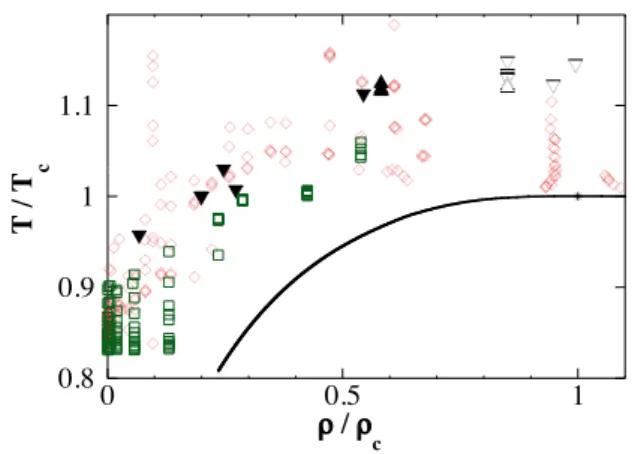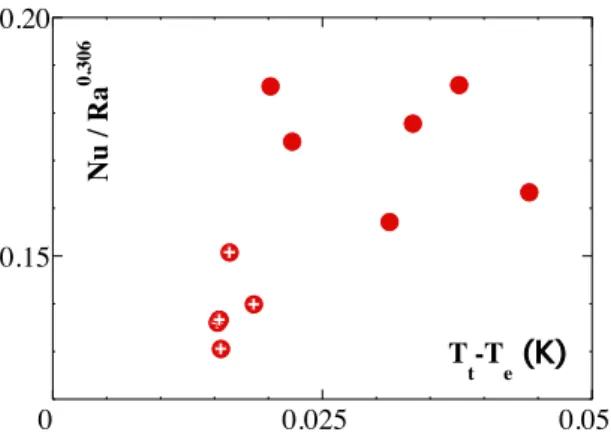HAL Id: hal-00020417
https://hal.archives-ouvertes.fr/hal-00020417
Preprint submitted on 9 Mar 2006
HAL is a multi-disciplinary open access
archive for the deposit and dissemination of
sci-entific research documents, whether they are
pub-lished or not. The documents may come from
teaching and research institutions in France or
abroad, or from public or private research centers.
L’archive ouverte pluridisciplinaire HAL, est
destinée au dépôt et à la diffusion de documents
scientifiques de niveau recherche, publiés ou non,
émanant des établissements d’enseignement et de
recherche français ou étrangers, des laboratoires
publics ou privés.
Comment on ”Turbulent heat transport near critical
points: Non-Boussinesq effects” ( cond-mat/0601398 )
Xavier Chavanne, Philippe-Emmanuel Roche, Benoît Chabaud, Bernard
Hébral, Francesca Chillà, Bernard Castaing
To cite this version:
Xavier Chavanne, Philippe-Emmanuel Roche, Benoît Chabaud, Bernard Hébral, Francesca Chillà,
et al.. Comment on ”Turbulent heat transport near critical points: Non-Boussinesq effects” (
cond-mat/0601398 ). 2006. �hal-00020417�
ccsd-00020417, version 1 - 9 Mar 2006
APS/123-QED
Comment on “Turbulent heat transport near critical points: Non-Boussinesq effects”.
X. Chavanne
Institut de Physique du Globe de Paris, G´eomat´eriaux et Environnement, 4, place Jussieu - Case 89 - 75252 Paris Cedex 05
P.-E. Roche, B. Chabaud, and B. H´ebral Centre de Recherche sur les Tr`es Basses Temp´eratures
CNRS, Associ´e `a l’Universit´e Joseph Fourier 25, Av. des Martyrs, BP 166, 38042 Grenoble Cedex 9
F. Chill`a and B. Castaing Ecole Normale Sup´erieure de Lyon, 46, All´ee d’Italie, 69364 Lyon Cedex 7, France
(Dated: 9/march/2006)
In a recent preprint ( cond-mat/0601398 ), D. Funfschilling and G. Ahlers describe a new effect, that they interpret as non-Boussinesq, in a convection cell working with ethane, near its critical point. They argue that such an effect could have spoiled the Chavanne et al. (Phys. Rev. Lett. 79 3648, 1997) results, and not the Niemela et al. (Nature, 404, 837, 2000) ones, which would explain the differences between these two experiments. We show that:
-i)Restricting the Chavanne’s data to situations as far from the critical point than the Niemela’s one, the same discrepancy remains.
-ii)The helium data of Chavanne show no indication of the effect observed by D. Funfschilling and G. Ahlers.
PACS numbers: 47.27
The question of whether or not the fully turbulent Kraichnan regime [1, 2] has been observed in Rayleigh-B´enard (RB) convection is a subject of vigorous contro-versy in the past decade. Chavanne et al.[3, 4] observed a rapid increase of the Nusselt number N u versus the Rayleigh number Ra, and interpreted it as the transition toward this ultimate regime. The difference between the observed logarithmic slope of this dependence and the predicted 1/2 exponent was attributed to the logarithmic correction proposed by Kraichnan himself [1, 2]. Roche et al. [5] showed that rough boundaries fix the correction as expected and induce a 1/2 exponent behaviour. Later, Niemela and Sreenivasan [6] reported the same kind of behaviour.
However Wu et al. [7, 8] and Niemela et al. [9] explored the same range of Ra, with the same working fluid (he-lium) without observing the same increase in N u. Sev-eral propositions have been made, but there exist no clear consensus about the differences between the cells which could explain such a discrepancy.
In a recent work, D. Funfschilling and G. Ahlers (FA) [10] observe a new effect, that they interpret as spurious (non-Boussinesq), in their convection cell working with ethane, near its critical point. They remark that most of the working points of the works observing the Kraichnan like behaviour [3, 4, 5, 6] are nearer the critical point and/or the gas-liquid coexistence curve of helium than those not observing it [7, 8, 9]. They thus propose that this spurious effect explains the difference quoted above, which would mean that the Kraichnan regime has not yet been experimentally observed.
In their figure 4, they indicate the position of the
dif-0.8 0.9 1 1.1 0 0.5 1 T / T c ! / ! c
FIG. 1: Phase diagram of4
He in reduced units (Tc= 5.1953
K, ρc= 69.641 kgm− 3
) showing the location of various mea-surements of N u versus Ra. Solid line: coexistence curve. Asterisc: critical point. Open diamonds: Niemela et al. [9]. Open squares: Wu et al. [7, 8]. Triangles up and down: Cha-vanne et al. [4]; triangles up: β∆T < 0.1, triangles down: β∆T > 0.1, open: near the critical isochore, solid: far from the critical isochore.
ferent working points in the phase space. It can be seen that some of the points of Chavanne et al. are within the points of Niemela et al.. In our figure 1 we reproduce only these points (triangles up and down). The temper-ature T is Tm= (Tb+ Tt)/2, where Tt (resp. Tb) is the
top (resp. bottom) plate temperature. ρ is the fluid av-erage density, Tc and ρc are the critical temperature and
2 density. We also show the Niemela et al. [9] points
(dia-monds), recently provided to us by J.J. Niemela, and the Wu et al. [7, 8] points (squares). We note that some of the points of Niemela et al., not shown on the FA figure 4, are very near the critical point, however not showing the Kraichnan like increase in N u [9].
0.10 0.15 0.20 1010 1011 1012 1013 1014 Nu / Ra 0.306 Ra
FIG. 2: The compensated Nusselt versus the Rayleigh num-ber. Circles: FA results as presented in their figure 5 (open: isothermal, solid: isobaric with ∆T = 1 K, P/Pc = 0.920).
Other symbols are as in figure 1.
In figure 1, and in the following one 2 we do several dis-tinctions between the Chavanne’s points we kept. Points with β∆T < 0.1, where β is the isobaric expansion co-efficient and ∆T = Tb− Tt, are plotted as triangles up.
We can consider for these points that physical proper-ties are reasonably uniform within the cell. Points with β∆T > 0.1 are plotted as triangles down. To eliminate any doubt, we also distinguish densities far from the criti-cal one (solid symbols) from those near it (open symbols). Following FA ([10] figure 3), we plot in our figure 2 N ucomp = N u/Ra
0.306 versus Ra for the Chavanne’s
points we kept. The symbols are the same than in figure 1. Also shown are the FA results (circles) as presented in their figure 5 (open: isothermal, solid: isobaric with ∆T = 1 K), and the Niemela’s points [9]. The discrep-ancy remains for these points which have the same loca-tion in the phase space. The Kraichnan like increase for the Chavanne’s points is obvious. We can easily conclude that the discrepancy between references [3, 4] and [9] has nothing to do with the location in the phase space.
Another question is to know if whether or not the characteristics of the effect observed by Funfschilling and Ahlers can be found in the data of Chavanne et al.. Fun-fschilling and Ahlers have shown that, in their observa-tions, the compensated Nusselt N ucomp = N u/Ra0.306
only depends on the difference between Tt(not Tm) and
the equilibrium temperature Teat the same pressure (this
corresponding to Tmand ρ).
There are no constant pressure series of measurements in Chavanne’s data [3, 4]. The reason is that ensuring a constant pressure ask for letting the filling capillary
0.15 0.20 0 0.025 0.05 Nu / Ra 0.306 T t -T e (K)
FIG. 3: Compensated Nusselt versus the difference between the top plate temperature and the condensation temperature at the considered pressure. All the points correspond to the same density: 37.9 kgm−3. The circles with cross correspond
to the same pressure within ±0.2% (P = 1.955 bar, P/Pc=
0.86) 0.15 0.20 1010 1011 1012 1013 Nu / Ra 0.306 Ra
FIG. 4: Same points as figure 3 plotted versus Ra.
open up to a pressure gauge or ballast. On some points of the capillary, the temperature can go down to the con-densation temperature Te. Together with the important
compressibility near the critical point, it can cause large transfers of mass and heat in this capillary. However sev-eral series of measurements in [3, 4] have been made at constant density ρ. On the figure 3 we plot the compen-sated Nusselt versus (Tt− Te) for the Chavanne’s points
corresponding to ρ = 37.9 kgm−3. The strongly different
values do not merge on a curve. On the opposite, they nicely merge if plotted versus Ra (figure 4). We draw the attention of the reader on the points labeled with a cross in the circle. Their corresponding pressure is the same within ±0.2%, which is not as precise as the ±3 10−5of
Funfschilling and Ahlers, but rather constant anyway. To conclude, the simple examination of the published data of Chavanne et al. shows that the hypothesis raised
3 by Funfschilling and Ahlers [10], that the influence of
the critical point could explain the apparent discrepancy between references [3, 4] and [9], this hypothesis cannot hold. Moreover, as far as the effect observed by them [10] is well characterized, we found no trace of it in the helium data of [3, 4]. We see here no reason to reconsider the original interpretation for the increase of N u observed by [3, 4, 5] as a transition toward the Kraichnan regime, even if the exact conditions for such a transition have yet to be elucidated.
Acknowledgments
We are grateful to J.J. Niemela for providing us the numerical values corresponding to the data in Ref. [9]. We also thank G. Ahlers for supplementary details on the cell and on ethane properties.
[1] R. H. Kraichnan, “Turbulent Thermal Convection at Arbitrary Prandtl Number”, Phys. Fluids, 5, 1374–1389, (1962).
[2] E. Siggia, “High Rayleigh Number Convection” Annual Review of Fluid Mechanics, 26, 137–168, (1994) [3] X. Chavanne, F. Chill`a, B. Castaing, B. H´ebral, B.
Chabaud, and J. Chaussy, “ Observation of the Ultimate Regime in Rayleigh-B´enard Convection” Phys. Rev. Lett. 79, 3648–3651 (1997).
[4] X. Chavanne, F. Chill`a, B. Chabaud, B. Castaing, B. H´ebral, “Turbulent Rayleigh-B´enard convection in gaseous and liquid He” Phys. Fluids 13, 1300–1320, (2001).
[5] P.-E. Roche, B. Castaing, B. Chabaud, and B. H´ebral, “Observation of the 1/2 power law in Rayleigh-B´enard convection” Phys. Rev. E 63, 045303–1–4 (2001) [6] J. J. Niemela, K. R. Sreenivasan, “Confined turbulent
convection” J. Fluid Mech., 481, 355–384 (2003) [7] X. Z. Wu,“Along a road to developped turbulence: free
thermal convection in low temperature helium gas”, PhD Thesis, Chicago University, (1991).
[8] X. Z. Wu, A. Libchaber, “Scaling relations in thermal turbulence: The aspect-ratio dependence” Phys. Rev. A 45, 842–845 (1992); M. Sano, X. Z. Wu, A. Libchaber, “Turbulence in helium-gas free convection” Phys. Rev. A 40, 6421–6430 (1989)
[9] J. J. Niemela, L. Skrbek, K. R. Sreenivasan, R. J. Don-nelly, “Turbulent convection at very high Rayleigh num-bers” Nature, 404, 837–841, (2000).
[10] D. Funfschilling and G. Ahlers, “Turbulent heat trans-port near critical points: Non-Boussinesq effects” cond-mat/0601398 (2006)

